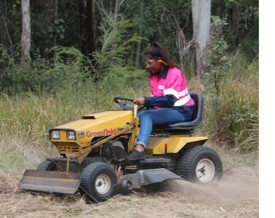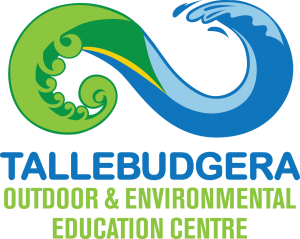 AHC21020 Certificate II in Conservation and Ecosystem Management is delivered in partnership with schools or alternative learning facilities as part of the Department of Education’s VET Pathways Program which is an agreement between First Nations Strategy and Partnerships and Tallebudgera Outdoor and Environmental Education Centre’s Registered Training Organisation. The program is targeted at but not limited to First Nations students.
AHC21020 Certificate II in Conservation and Ecosystem Management is delivered in partnership with schools or alternative learning facilities as part of the Department of Education’s VET Pathways Program which is an agreement between First Nations Strategy and Partnerships and Tallebudgera Outdoor and Environmental Education Centre’s Registered Training Organisation. The program is targeted at but not limited to First Nations students.
The purpose of the VET Pathways Program is to deliver Certificate courses to students across Queensland with the goal of increasing their employment prospects by attaining a Queensland Certificate of Education (QCE), learning in real world contexts, enriching cultural knowledge and connecting to community.
Conservation and Ecosystem Management is an industry dealing with the management and restoration of land that has been degraded as a result of human activities. It involves working on natural areas that have been impacted or disturbed by people and bringing them back to a healthy condition. These sites are often weed infested, the soil has been eroded and the natural vegetation has been removed.
This course gives students the opportunity to learn about different ecosystems and how to perform land management tasks such as identifying plants and animals, planting trees, treating weeds, operating basic types of machinery and equipment and maintaining Aboriginal and Torres Strait Islander cultural sites. This enables students to be able to complete further learning in this pathway e.g. Certificate III in On Country Management, or to gain employment in industries such as bush regeneration, landscaping, controlling weeds or as a plant nursery worker.
Units of Competency
AHC21020 Certificate II in Conservation and Ecosystem Management benefits students in the following ways:
- Contributes four credits towards a Queensland Certificate of Education (QCE) and satisfies QCE completed core requirements (provided the student has achieved 90% new learning)
- Includes transferable workplace skills and knowledge, particularly in conservation and ecosystem management industries
- Builds students’ capability for workforce entry or further vocational training pathways.
Students will complete all of the following 15 units of competency (2 Core Units and 13 Electives):
| National Code | Competency Title | Core/Elective |
| AHCWHS202 | Participate in workplace health and safety processes | Core |
| AHCWRK211 | Participate in environmentally sustainable work practices | Core |
| AHCFAU202 | Recognise fauna | Elective Group A |
| AHCOCM201 | Maintain cultural sites | Elective Group A |
| AHCOCM202 | Observe and report plants or animals | Elective Group A |
| AHCECR202 | Maintain wildlife habitat refuges | Elective Group A |
| AHCPMG201 | Treat weeds | Elective Group A |
| AHCPCM204 | Recognise plants | Elective Group A |
| AHCPGD207 | Plant trees and shrubs | Elective Group B |
| AHCLSC210 | Install tree protection devices | Elective Group B |
| TLID0020 | Shift materials safely using manual handling methods | Elective Group B |
| AHCMOM203 | Operate basic machinery and equipment | Elective Group B |
| FSKRDG009 | Read and respond to routine standard operating procedures | Imported unit |
| AHCOCM301 | Provide information on Aboriginal and/or Torres Strait Islander Peoples’ cultural practice | Imported unit |
| FSKLRG014 | Manage strategies for career progression | Imported unit |
Language, Literacy and Numeracy requirements
Students need to have the following language, literacy and numeracy skills to be successful in this course:
| Reading | Able to interpret a range of workplace texts and identify key information in order to perform a task e.g. Safety Operating Procedures, Safety Data Sheets, information on chemical ratios and application techniques. |
| Writing | Able to answer written questions, complete log books and a field guide using appropriate workplace language and terminology. |
| Numeracy | Able to perform basic mathematical calculations and take measurements. |
| Oral Communication | Able to seek clarification from supervisor, participate in group discussions and informal meetings, speak appropriately to work colleagues, guests and peers. |
| Work skills | Able to follow instructions, behave appropriately and responsibly in a workplace, monitor and reflect on personal progress, contribute to the team. |
Volume of Learning
The volume of learning of a Certificate II is typically 6 months – 1 year. The volume of learning is made up of all the work the student is required to complete to meet the requirements of the training package. The duration of the course will be determined according to the current skills of the learner cohort and the time allocated to learning each week. The student’s school or employer organisation must provide the RTO with an indication of how the learning will fit in to the student’s school or work program prior to enrolment to ensure it is sufficient and the course can be completed in a reasonable time frame.
Delivery Model
The course is delivered through a flexible learning model which includes written theory components that can be completed indoors and practical components that are best undertaken alongside workers from organisations such as Natural Resource Management Groups, Indigenous Ranger groups, National Park Rangers, Plant Nurseries, Local Councils or local environmental or conservation groups.
Training and Assessment
Students will be assessed using a number of different methods including direct observation, questioning, work records and log books.
Training and Assessment will remain the responsibility of the RTO. All training and assessment materials are provided and completed coursework must be returned to Tallebudgera Outdoor and Environmental Education Centre for final assessment. The student’s results will be reported to the Queensland Curriculum and Assessment Authority (QCAA) on completion of the course for inclusion on the student’s Queensland Certificate of Education.
No VETiS Funding
As Tallebudgera OEEC is a Queensland Government school, the RTO is not eligible to become a Skills Assure Supplier so is unable to provide services subsidised by the Department of Employment, Small Business and Training. This includes VET in Schools (VETiS) funding, the User Choice Program, apprenticeships or traineeships.
Course costs
Total costs per student for the qualification are as follows:
| Certificate II qualification – includes all printed or electronic learning materials and teacher resources, assessment of work, access to the online component and issue of the AQF qualification. | $350.00 |
How to enrol students
To enrol students or for more information about the course, please contact your Student Support Officer:
Roslyn Cridland
Senior Project Officer
Tallebudgera Outdoor and Environmental Education Centre RTO (Code 30685)
Ph: 5520 9316 ; Mobile: 0477 345 184; Email: rcrid2@eq.edu.au
